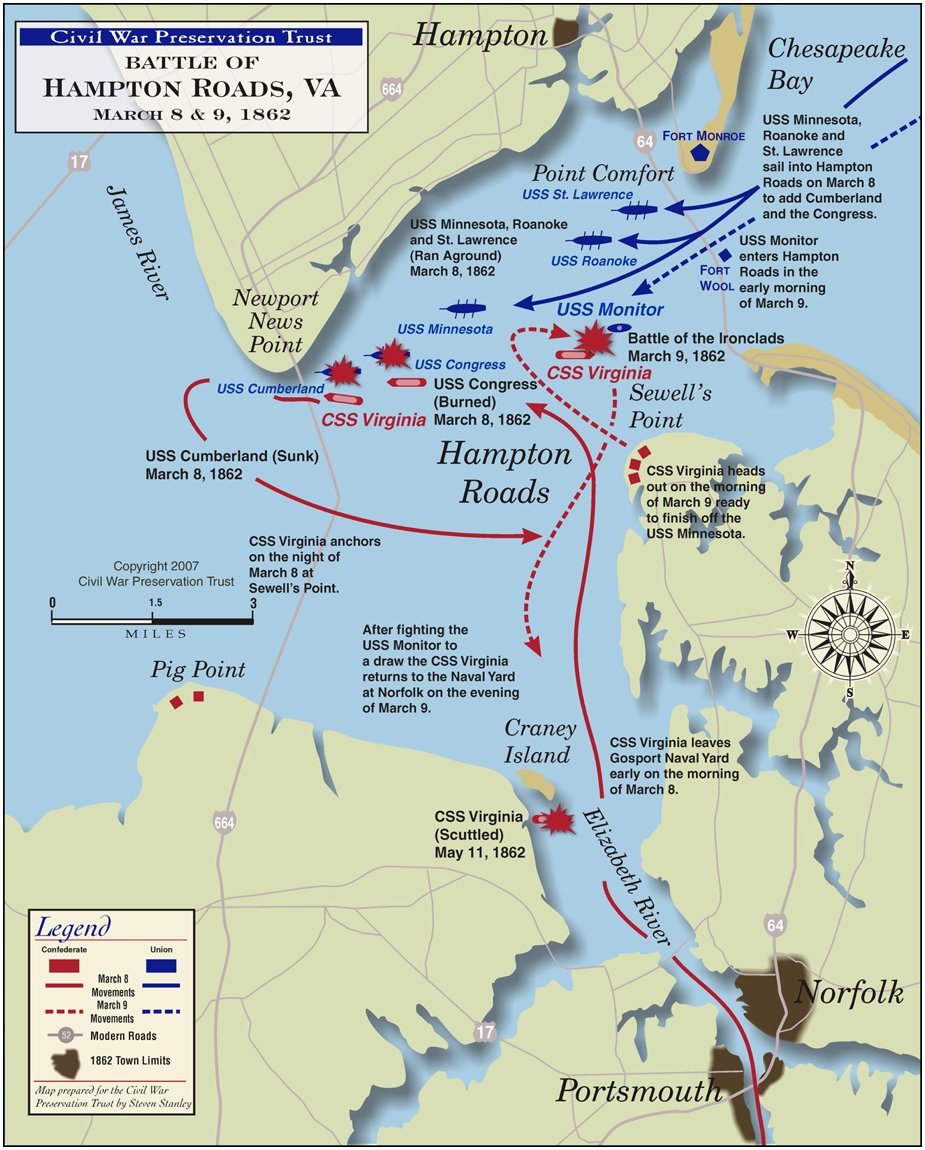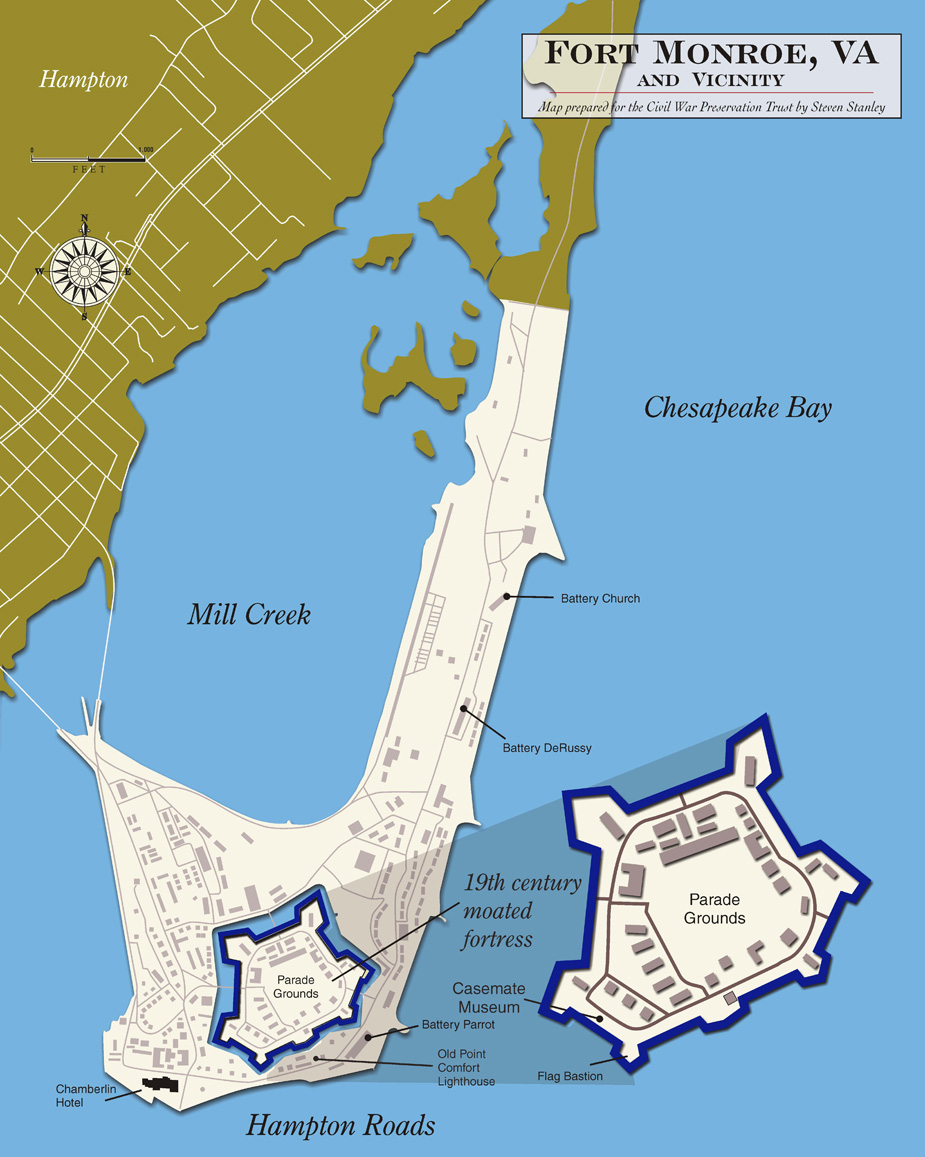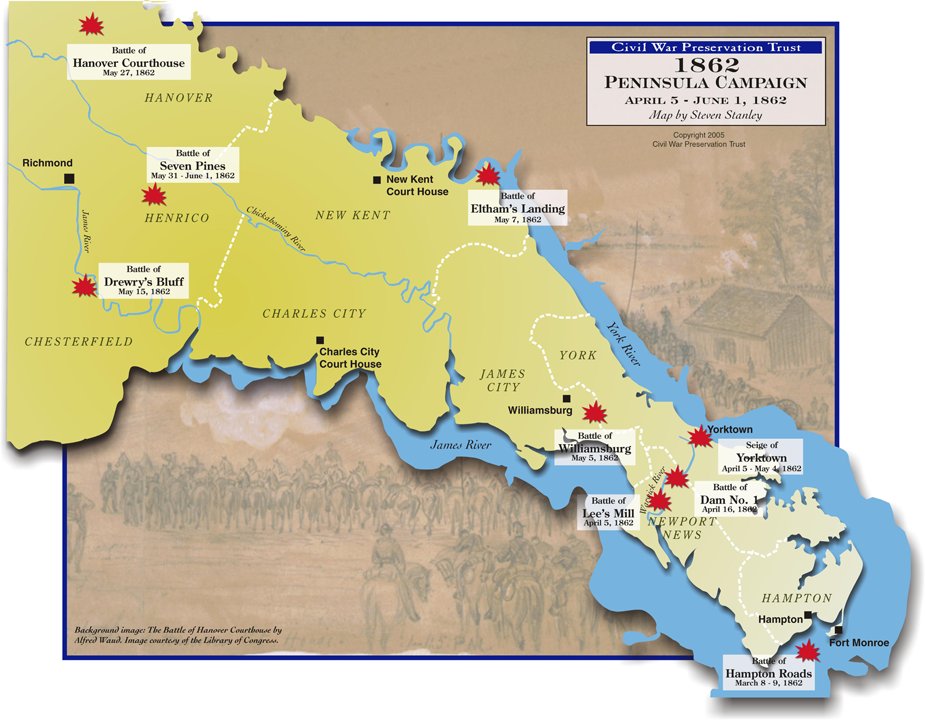|
Battle of Hampton Roads
Other Names: Monitor vs. Virginia, Monitor Merrimack Battle,
Battle of the Ironclads, Duel of the Ironclads, Monitor and Merrimac Fight
Location: Hampton Roads, Virginia
Campaign: Peninsula Campaign (March-July 1862)
Date(s): March 8-9, 1862
Principal Commanders: Lt. John Worden [US]; Capt. Franklin Buchanan
and Lt. Catesby ap R. Jones [CS]
Forces Engaged: 4 warships [US]; 1 warship [CS]
Estimated Casualties: 433 total (US 409; CS 24)
Result(s): Inconclusive
| CSS Virginia (ex-USS Merrimack) vs. USS Monitor |

|
| Battle of Hampton Roads |
Description: On March 8, 1862, from her berth at Norfolk, the
Confederate ironclad Virginia (formerly Merrimack) steamed into Hampton Roads where she sank Cumberland and ran Congress
aground. On March 9, the Union ironclad Monitor, having fortuitously arrived to do battle, initiated the first engagement
of ironclads in history. The two ships fought each other to a standstill, but Virginia retired.
Significance: The Battle of Hampton Roads, often referred
to as the Battle of Monitor and Merrimack (often misspelled or misidentified as the Merrimac, which
was a different vessel), and the Battle of the Ironclads, was the most noted and arguably the most important naval battle
of the American Civil War from the standpoint of the development of navies. It was fought over two days, 8–9 March 1862,
in Hampton Roads, Virginia, and it rendered every single navy in the world obsolete. Numerous well documented first-hand accounts,
from Union and Confederate seamen and officials to civilians and onlookers, have assisted greatly in preserving the
world's first ironclad duel: Battle of Hampton Roads: Official Reports and USS Monitor Versus
CSS Virginia (aka Monitor - Merrimack Battle).
Who Won the Battle of Hampton Roads?
The victory claims that
were made by each side in the immediate aftermath of the Battle of Hampton Roads, based as both were on misinterpretations
of the opponent's behavior, have been dismissed by present-day historians. They agree that the result of the Monitor-Merrimack
encounter was victory for neither. As the combat between ironclads was the primary significance of the battle, the general
verdict is that the overall result was a draw. All would acknowledge that the Southern fleet inflicted far more damage than
it received, which would ordinarily imply that they had gained a tactical victory. Compared to other Civil War battles, the
loss of men and ships for the Union Navy would be considered a clear defeat. On the other hand, the blockade was not seriously
threatened, so the entire battle can be regarded as an assault that ultimately failed.
| Battle of Hampton Roads Map |

|
| Map of Monitor-Virginia Battle, aka Monitor-Merrimack Battle |
Evaluation of the strategic
results is likewise disputed. The blockade was maintained, even strengthened, and Virginia was bottled up in Hampton Roads. Because a decisive
Confederate weapon was negated, some have concluded that the Union could claim a strategic
victory. Confederate advocates can counter, however, by arguing that Virginia had a
military significance larger than the blockade, which was only a small part of the war in Tidewater Virginia. Her mere presence
was sufficient to close the James River to Federal incursions. She also imposed other constraints
on the Peninsula Campaign then being mounted by the Union Army under General George B. McClellan,
who worried that she could interfere with his positions on the York River. Although his fears
were baseless, they continued to affect the movements of his army until Virginia
was destroyed.
| Fort Monroe Map |

|
| Map of Fort Monroe Virginia, and Hampton Roads Area |
Impact upon Naval
Warfare
Both days of the battle
attracted attention from all the world's navies. USS Monitor became the prototype for the monitor warship type. Many more
were built, including river monitors, and they played key roles in Civil War battles on the Mississippi and James rivers.
The US immediately started the construction of ten more monitors based on Ericsson's
original larger plan, known as the Passaic-class monitors. However, while the design proved exceptionally well-suited for
river combat, the low profile and heavy turret caused poor seaworthiness in rough waters. Russia,
in fear of being drawn into the American Civil War, launched ten sister ships, as soon as Ericsson's plans reached St. Petersburg. What followed has been described as "Monitor mania".
The revolving turret later inspired similar designs for future warships, which eventually became the modern battleship.
| Peninsula Campaign Map |

|
| Map of Peninsula Campaign and Battles |
The
vulnerability of wooden hulls to armored ships was noted particularly in Britain and France,
where the wisdom of the planned conversion of the battle fleet to armor was given a powerful demonstration. Another feature
that was emulated was not so successful. Impressed by the ease with which the Virginia had
sunk the Cumberland, naval architects began to incorporate
rams into their hull designs. The first purpose-built ram in the modern era was the French armored ram Taureau (1863), whose
guns were said to have "the sole function of preparing the way for the ram." The inclusion of rams in warship hull design
persisted almost to the outbreak of World War I, despite improvements in naval gunnery that quickly made close action between
warships almost suicidal, if not impossible. See also: Battle of Hampton Roads: A Civil War History.
(Sources and related reading below.)
Recommended
Reading: The Battle of Hampton
Roads: New Perspectives on the USS Monitor and the CSS Virginia (Mariner's Museum). Description: On March 8 and 9, 1862, a sea battle off the Virginia coast changed naval warfare forever. It began when the Confederate States Navy’s
CSS Virginia led a task force to break the Union blockade of Hampton Roads. The Virginia
sank the USS Cumberland and forced the frigate Congress to surrender. Damaged by shore batteries, the Virginia retreated, returning the next day to find her way blocked by the newly arrived
USS Monitor. The clash of ironclads was underway. Continued below…
After fighting
for nine hours, both ships withdrew, neither seriously damaged, with both sides claiming victory. Although the battle may
have been a draw and the Monitor sank in a storm later that year, this first encounter between powered, ironclad warships
spelled the end of wooden warships—and the dawn of a new navy. This book takes a new look at this historic battle. The
ten original essays, written by leading historians, explore every aspect of the battle—from the building of the warships
and life aboard these “iron coffins” to tactics, strategy, and the debates about who really won the battle of
Hampton Roads. Co-published with The Mariners’ Museum, home to the USS Monitor Center, this authoritative guide to the
military, political, technological, and cultural dimensions of this historic battle also features a portfolio of classic lithographs,
drawings, and paintings. Harold Holzer is one of the country’s leading experts on the Civil War.
Recommended
Reading: Ironclad Down: USS Merrimack-CSS Virginia from Design to Destruction (Hardcover). Description: The result of more than fifteen years
of research, Ironclad Down is a treasure trove of detailed information about one of history s most famous vessels. Describing
the fascinating people--Stephen Russell Mallory, John Mercer Brooke, John Luke Porter, et al.--who conceived, designed and
built one of the world's first ironclads as well as describing the ship itself, Carl Park offers both the most thoroughly
detailed, in-depth analysis to date of the actual architecture of the Virginia
and a fascinating, colorful chapter of Civil War history.
Recommended
Reading: Confederate Ironclad vs Union Ironclad: Hampton Roads
1862 (Duel). Description: The Ironclad
was a revolutionary weapon of war. Although iron was used for protection in the Far East
during the 16th century, it was the 19th century and the American Civil War that heralded the first modern armored self-propelled
warships. With the parallel pressures of civil war and the industrial revolution, technology advanced at a breakneck speed.
It was the South who first utilized ironclads as they attempted to protect their ports from the Northern blockade. Impressed
with their superior resistance to fire and their ability to ram vulnerable wooden ships, the North began to develop its own
rival fleet of ironclads. Eventually these two products of this first modern arms race dueled at the battle of Hampton Roads
in a clash that would change the face of naval warfare. Continued below…
Fully illustrated
with cutting-edge digital artwork, rare photographs and first-person perspective gun sight views, this book allows the reader
to discover the revolutionary and radically different designs of the two rival Ironclads - the CSS Virginia and USS Monitor
- through an analysis of each ship's weaponry, ammunition and steerage. Compare the contrasting training of the crews and
re-live the horrors of the battle at sea in a war which split a nation, communities and even families. About the Author: Ron
Field is Head of History at the Cotswold School in
Bourton-on-the-Water. He was awarded a Fulbright Scholarship in 1982 and taught history at Piedmont
High School in California
from 1982 to 1983. He was associate editor of the Confederate Historical Society of Great Britain, from 1983 to 1992. He is
an internationally acknowledged expert on US Civil War military history, and was elected a Fellow of the Company of Military
Historians, based in Washington, DC,
in 2005. The author lives in Cheltenham, UK.
Recommended
Reading: A History of Ironclads: The Power of Iron over Wood. Description: This
landmark book documents the dramatic history of Civil War ironclads and reveals how ironclad warships revolutionized naval
warfare. Author John V. Quarstein explores in depth the impact of ironclads during the Civil War and their colossal effect
on naval history. The Battle of Hampton Roads was one of history's greatest naval engagements. Over the course of two days
in March 1862, this Civil War conflict decided the fate of all the world's navies. It was the first battle between ironclad
warships, and the 25,000 sailors, soldiers and civilians who witnessed the battle vividly understood what history would soon
confirm: wars waged on the seas would never be the same. Continued below…
About the Author: John V. Quarstein is an award-winning author and historian. He is director
of the Virginia
War Museum in Newport News and chief historical advisor for The Mariners' Museum's new USS Monitor Center
(opened March 2007). Quarstein has authored eleven books and dozens of articles on American, military and Civil War history,
and has appeared in documentaries for PBS, BBC, The History Channel and Discovery Channel.
Recommended
Reading: Iron Afloat:
The Story of the Confederate Armorclads.
Description: William N. Still's book is rightfully referred to as the standard of Confederate Naval history. Accurate and
objective accounts of the major and even minor engagements with Union forces are combined with extensive background information.
This edition has an enlarged section of historical drawings and sketches. Mr. Still explains the political background that
gave rise to the Confederate Ironclad program and his research is impeccable. An exhaustive literature listing rounds out
this excellent book. While strictly scientific, the inclusion of historical eyewitness accounts and the always fluent style
make this book a joy to read. This book is a great starting point.
Recommended
Viewing: The First Ironclads - Into the Modern Era (DVD) (2008). Description: This is the story of the great vessels, the formidable
warships, the epic ironclads (early battleships), that changed forever naval ship design as well as naval warfare: the Monitor,
the Merrimack (later renamed the Virginia) and it presents a fascinating animated
reconstruction of their epic battle during the American Civil War. Continued below...
The Battle
of Hampton Roads, aka Duel of the Ironclads, which made the world's navies tremble as well as obsolete, is handsomely depicted
in this video. The First Ironclads – Into the Modern Era is a welcome addition for the individual interested in the
Civil War, U.S. Naval Warfare, and shipbuilding and design. It also includes footage from aboard the world's most devastating
“sailing ironship” the HMS Warrior.
Recommended
Reading: A History of the Confederate Navy
(Hardcover). From Publishers Weekly: One of the most prominent European scholars of the Civil War weighs in with a provocative
revisionist study of the Confederacy's naval policies. For 27 years, University of Genoa history professor Luraghi (The Rise
and Fall of the Plantation South) explored archival and monographic sources on both sides of the Atlantic to develop a convincing
argument that the deadliest maritime threat to the South was not, as commonly thought, the Union's blockade but the North's
amphibious and river operations. Confederate Navy Secretary Stephen Mallory, the author shows, thus focused on protecting
the Confederacy's inland waterways and controlling the harbors vital for military imports. Continued below…
As a result,
from Vicksburg
to Savannah to Richmond, major
Confederate ports ultimately were captured from the land and not from the sea, despite the North's overwhelming naval strength.
Luraghi highlights the South's ingenuity in inventing and employing new technologies: the ironclad, the submarine, the torpedo.
He establishes, however, that these innovations were the brainchildren of only a few men, whose work, although brilliant,
couldn't match the resources and might of a major industrial power like the Union. Nor did
the Confederate Navy, weakened through Mallory's administrative inefficiency, compensate with an effective command system.
Enhanced by a translation that retains the verve of the original, Luraghi's study is a notable addition to Civil War maritime
history. Includes numerous photos.
Sources: National Park Service; US Navy, Washington; Anderson, Bern (1962). By sea and by
river: the naval history of the Civil War. Knopf; reprint, Da Capo, n.d.. ISBN 0-306-80367-4; Browning, Robert M. Jr. (1993).
From Cape Charles to Cape
Fear: the North Atlantic Blockading Squadron during
the Civil War. University of Alabama.
ISBN 0-8173-5019-5; Davis, William C. (1975). Duel between the first ironclads. Doubleday, Durkin, Joseph T. (1954). Stephen
R. Mallory: Confederate Navy chief. University of North
Carolina; reprint, University of South Carolina, 1987. ISBN 0-87249-518-3; Gibbons, Tony (1983). The complete encyclopedia
of battleships: a technical directory of capital ships from 1860 to the present day. Salamander Books. ISBN 0-517-378108;
Luraghi, Raimondo (1996). A history of the Confederate Navy. Annapolis,
Md.: Naval Institute Press. ISBN 1-55750-527-6: (translation by Paolo E. Coletta
of Marina del Sud: storia della marina confederate nella Guerra Civile Americana, 1861-1865. Rizzoli, 1993.); Musicant, Ivan
(1995). Divided waters: the naval history of the Civil War. HarperCollins. ISBN 0-06-016482-4; Scharf, J. Thomas (1887; reprint,
Random House, 1996.). History of the Confederate States Navy from its organization to the surrender of its last vessel; its
stupendous struggle with the great Navy of the United States, the engagements fought in the rivers and harbors of the South
and upon the high seas, blockade-running, first use of iron-clads and torpedoes, and privateer history. New York: Rogers & Sherwood; Simson,
Jay W. (2001). Naval strategies of the Civil War: Confederate innovations and Federal opportunism. Nashville:
Cumberland House. ISBN 1581821956; Still, William N. Jr. (1985).
Iron afloat: the story of the Confederate armorclads. Vanderbilt
University. ISBN 0-87249-616-3; Tucker, Spencer (2006). Blue & gray
navies: the Civil War afloat. Annapolis: Naval Institute Press.
ISBN 1591148820; United States Department of the Navy, Naval History Department (1971). Civil War naval chronology, 1861–1865.
Government Printing Office; Wise, Stephen R. (1988). Lifeline of the Confederacy: blockade running during the Civil War. University of South Carolina.
ISBN 0-87249-554; Civil War Preservation Trust.
|

